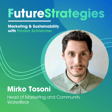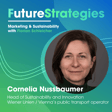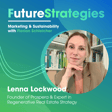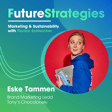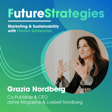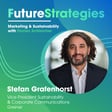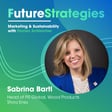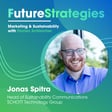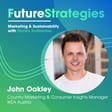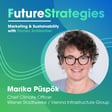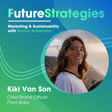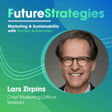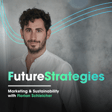Become a Creator today!Start creating today - Share your story with the world!
Start for free
00:00:00
00:00:01

⭐️ Scarcity in Marketing and Sustainability
This recording is based on one of the top 5 most read newsletters of the last year on Scarcity in marketing.
You are listening to the Summer Edition of the FutureStrategies Podcast - A show about where marketing, strategies and sustainability intersect. I am currently taking a break from interviews. So you will get 5 short episodes over the summer, where I will lead you through the most read postings of my newsletter. Interviews will be back in autumn 2024.
About the FutureStrategies podcast and your host:
I’m Florian Schleicher, a marketing strategist. I help brands gain clarity, spark momentum, and turn strategy into something that actually moves people. In 2022, I started my marketing studio FUTURESTRATEGIES. to do exactly that. I currently work with corporate clients from 11 countries.
If you want more, check out my FutureStrategies newsletter – weekly inspiration on marketing, strategy and sustainability.
And if something’s blocking your brand from doing its best work, let’s talk.
Transcript
Introduction & Podcast Overview
00:00:00
Speaker
Hello, my name is Florian Schleicher and this is the Future Strategies Podcast, a show about where marketing, strategies and sustainability intersect. You're listening to the Summer Edition, where you will get five short episodes where I will lead you through the most read postings of my newsletter. So over the next couple of weeks, you will get a best off with me. And if you want to read them all, you can sign up anytime with the link in the show notes. I will be back with more exciting interviews from inspiring leaders in autumn this year. So now you can just relax, enjoy, and we'll jump right into it.
Understanding Scarcity in Marketing
00:00:40
Speaker
Today I want to talk about scarcity. What do McDonald's, the Faroe Islands, Lacoste and Diamonds have in common? They all work with scarcity in marketing. How does it work? And how can brands use it to their advantage? I wasn't always sustainable. Before I helped shape and manage the marketing of Greenpeace and Too Good to Go, I was busy selling as many burgers as possible at McDonald's.
Lessons from McDonald's to Green Marketing
00:01:06
Speaker
I always talk about how I switched from the dark to the bright side with my focus on green marketing nowadays. But at McDonald's, I learned a lot of extremely valuable things about marketing, especially the art of artificial scarcity and how it can be used perfectly in marketing. And since I read a great book called The Power of Scarcity by Mindy Weinstein a few weeks ago, I would like to share some of my learnings here with you today.
00:01:34
Speaker
So we'll talk about what is scarcity marketing, why does scarcity work in marketing, how do successful companies use it to their advantage, and five tactics to use scarcity for green marketing. So let's jump right in.
Defining Scarcity Marketing
00:01:50
Speaker
What is scarcity? Entire sectors of the economy have been built on scarcity alone. What is this about? Every time a product is offered in limited quantities, a discount has limited duration, something is not freely available on the market, there are only a certain number of tickets, especially editionals released.
00:02:11
Speaker
Then we talk about scarcity. In her book Mindy Weinstein writes, when an item is scarce because of high demand versus other circumstances, the perceived value is even stronger. It creates a feeling of urgency based on the belief that once the products are sold, the chance to own the product is gone forever. It propels us to do something immediately. Free markets are defined by supply and demand. If there is more demand than supply, then sellers, in example companies, have a strategic advantage and can also work with this in their marketing.
Scarcity's Market Advantage
00:02:47
Speaker
When I was head of marketing at Too Good to Go, we launched in August 2019 with 23 companies that saved food with us.
00:02:56
Speaker
Soon after the launch, there were thousands of users. So we unintentionally made the market scars and wanted to create a balance as quickly as possible, precisely because Too Good To Go generates revenue with every sale, and we therefore needed a lot more supply to boost our sales. What it did bring us, however, was a hype about the available supply. And the most popular restaurants, bakeries and hotels, are still selling out quickly. One of the historically well-known examples of deliberate scarcity comes from the diamond company De Beers, one of the leading names in the industry. Thanks to De Beers, diamonds became a symbol of love.
00:03:39
Speaker
In the 1930s, the Beers launched the famous A Diamond is Forever campaign, which not only established the romantic link between diamonds and love, but also reinforced the idea that diamonds have a lasting value. In the late 19th century, large diamond deposits were discovered in South Africa, where the Beers mined a large proportion of its diamonds. This discovery could have theoretically led to an oversupply, which in turn could have caused prices to fall. To prevent this and keep prices at a high level, the Beers decided to take control of the diamond market. They created a monopoly by controlling not only the mining of diamonds but also the marketing.
00:04:23
Speaker
Their introduction of the A Diamond is Forever campaign in the 1930s strengthened consumers' emotional attachment to diamonds and created the impression that diamonds have a lasting value. The skillful combination of diamonds with emotions and the strategic handling of scarcity have made the beers a pioneer in the diamond industry and have had a lasting impact on the market.
Psychological Impact of Scarcity
00:04:47
Speaker
The company has since discontinued this tactic and campaign campaigned since the early 2000s but we still value diamonds as an extremely valuable resource. What has remained, however, is that resourceful marketers are still working with the element of artificial scarcity. But what is the psychology behind it? Why does scarcity work in marketing? Scarcity works because we humans are more afraid of loss than we are of gain.
00:05:17
Speaker
Mindy Weinstein writes the idea that something can be here today and gone tomorrow drives most of us crazy. It's what makes scarcity such a powerful influence in how we make decisions. Fear of not having something has existed for time immemorial. We are afraid of losing a deal and having to pay more afterwards, or worse, our desired product and service is no longer available at all. The effect of scarcity can be summarized quite simply. The less available something is, the more people will want it.
00:05:52
Speaker
An interesting example of this closing time effect, which influences why we often find people more attractive an hour later than at the beginning of the night, is illustrated in a study from the 1970s. Studies then have concluded that closing time threatened the freedom to choose someone to be with later, and consequently, those remaining in the bar increased in desirability and attractiveness. So when potential partners are perceived as less available, their value and desirability increase. Put simply, research has shown that we find someone more attractive and desirable when that person is not available to us. However, as Mindy Weinstein also writes, there must be first a certain level of interest.
00:06:41
Speaker
This principle is also the reason why anti-smoking campaigns have been using shocking images of dying and sick people for years. Fear is the strongest motivator to change behavior. We are afraid of no longer getting what we want.
Brand Loyalty through Scarcity
00:06:57
Speaker
Our reaction isn't because we desire freedom, it's because we fear loss. Therefore, we become motivated to restore what we feel is the freedom to choose. fancy a quick self-test? Think briefly about something you would like to have. Maybe a book, an item of clothing, a game, a movie ticket, a sports experience. And imagine you only have 15 minutes to decide whether you can have it at all. What do you do?
00:07:28
Speaker
According to studies, this shortage has several effects on us. First, we skip the normal steps involved in making a purchasing decision. Second, we no longer seek out additional information to help us decide whether to buy something or move on. Third, we are no longer confronted with competing products and offers because we are no longer looking for them. Instead, we are forced to buy immediately and on the spot. And that's great for companies. That is why I would now like to describe two examples of how successful companies use scarcity to their advantage.
00:08:08
Speaker
And that brings us back to my former employer, the big burger chain. Have you ever wondered why McDonald's launches different creations and products every month? Dean Barrett, the retired senior vice president of global marketing at McDonald's, describes how a brand uses limited time offers to build brand affinity and loyalty while encouraging interactions with customers. He says, McDonald's has a 60 year history of doing things that are fun and exciting and creating trends that connect with people's lives and what's happening around them, whether it's in the form of food or limited time promotions tied to big events like sporting events or major movie premieres around the world. The opportunity to make limited time offers for customers has become part of the brand culture. McDonald's uses limited time products to surprise and delight customers.
00:09:04
Speaker
For the company, time-limited offers are not about the spontaneous question, how much can I sell? But how can I connect customers with the brand and become part of the culture? This approach leads to lasting brand affinity and a connection with the customer's life. McDonald's deliberately issues limited time offers based on customers' current wishes or those they have expressed in the past. If a previous limited time offer was popular with customers, McDonald's considers offering it again and in many cases it has offered it repeatedly. However, it is also possible that the limited time offer is removed after a certain period of time in order to continue to surprise and amuse customers. In a way, the sporadic launch leads to a treasure hunt for fans.
00:09:57
Speaker
As a result, McDonald's has customers puzzling over the launch of the McRip or their favorite chicken McNugget and even demanding them. I remember well when I was a child and always wanted a happy meal, they called it a junior bag back then, to get the exclusive toy and complete my collection. We also saw this at the beginning of COVID.
Seasonal & Limited Edition Strategies
00:10:21
Speaker
If consumers think that there is a shortage of a product or that it won't be around for long, they will rush out to get it. Think of the great toilet paper shortage in 2020 and how many people rushed out to get some the moment they thought they might run out.
00:10:39
Speaker
Scarcity marketing almost always works. Starbucks has also cleverly incorporated this into its annual calendar, or to put it another way, it's pumpkin spice latte time. For a drink whose contents never saw a pumpkin in its first 10 years, the coffee company has been making quite a splash around the product for over 20 years. Mindy Weinstein describes the story of the product launch. The Starbucks team, responsible for selecting the flavors, brainstormed and came up with 10 product ideas. The team had customers taste the new drinks and the pumpkin drink fell in the middle of the spectrum.
00:11:21
Speaker
At this point, there were no drinks with pumpkin. The team decided to take the pumpkin idea further by creating a liquid lab of Thanksgiving-related items, including pumpkin pie, to cultivate the feeling of fall. At that time, it was mid-January. The company experimented with different autumnal flavors and decided on a recipe that didn't actually contain any pumpkin notes. to make a long story very short. The drink contains no pumpkin at all. Nevertheless, Starbucks named the drink Pumpkin Spiced Lutter, PSL. In 2002, the PSL was tested in Vancouver and Washington, DC. Within a week, sales skyrocketed, exceeding original projections. Starbucks struggled to keep up with inventory.
00:12:11
Speaker
Ten years after its launch, Starbucks had sold around 200 million PSLs. In 2019, there were around 424 million worldwide. The drink that almost didn't make it to the market has become the king of limited time seasonal drinks and has sparked a pumpkin spice movement. This hype surrounding the pumpkin spice latte is a prime example of how limited time supply leads to the perception of scarcity.
00:12:46
Speaker
The drink is only available for a limited time each year. Customers know they have to act before it's gone. The popularity of it prompts us to follow behavior of others and get caught up in the frenzy as well. However, neither Starbucks nor McDonald's are purely concerned with the direct sale of the products in the short supply, as the other products are also bought more frequently. Starbucks locations nationwide saw in-person visits increase by 25.7% in the week post-launch in 2022.
00:13:25
Speaker
The promotion of the unicorn frappuccino in 2017 was similar. Customers created over 150,000 Instagram posts for a promotion that only ran for four days. However, the drink had a bigger impact on Starbucks bottom line compared to the previous period. Total source sales were up 4% year on year. And that brings us to sustainability, because those two companies certainly aren't.
Authentic Scarcity in Green Marketing
00:13:55
Speaker
The tourist office, Visit Faroe Islands, claimed it was closed to all tourists for a weekend for maintenance. Since 2018, several tourist attractions on the Faroe Islands have been closed to regular tourists for two days, but open to volunteers or volunteerists who want to help with maintenance. Over the course of two days, visitors help shape the future of sustainable tourism on the Faroe Islands.
00:14:25
Speaker
These are a series of 18 windswept islands in the North Atlantic. Until recently, this rugged island chain was quite unknown to the world. Travelers have begun to discover its incredible nature. The aim of the annual closed-off maintenance project is to preserve all the pristine qualities for which the Faroe Islands are known today. The initiative is led by Visit Faroe Islands and is part of a larger effort to preserve these islands as one of the most pristine and least polluted places in the world. Their conservation project contributes to responsible travel and gives the local population a positive feeling in the midst of growing tourism.
00:15:10
Speaker
Visit Faroe Islands invites volunteers from abroad to join 40 local volunteers. The first 100 volunteers will be offered free accommodation, food and transportation in return for their help. This initiative attracted a great deal of attention in the media. It managed to combine sustainability with scarcity. Thousands of people applied for one of the 100 invitations, which was also advertised with a PR-friendly video, including an appeal by the Feroz Prime Minister, Axel Johansson.
00:15:45
Speaker
The campaign generated a media value of over US$500 million. A second sustainability-centered scarcity campaign comes from LaCost and was implemented in 2018 and again in 2019. Now let's briefly talk about the elephant in the room. The clothing company Lacoste is not necessarily a green marketing pioneer, but they have implemented an extremely strong campaign around endangered animals. As part of the International Biodiversity Day on May 22nd, they have replaced their iconic crocodile on the polo shirts with other endangered species.
00:16:28
Speaker
And in selected stores, the crocodile disappeared from the store for 24 hours and was replaced by an endangered animal. And for each polo, with a different animal, there were only the number of t-shirts still available of that animal species. A few examples. In the store on the Champs-Élysées in Paris, there were 589 specimens with the Iberian lynx. There are still 444 animals of the North Atlantic right whale in the world, whose counterparts were sold in the store on Broadway in New York City. And 1,400 polo shirts featuring the Hawaiian monk seal could be purchased in a webshot at lacoste.com.
00:17:14
Speaker
This campaign went viral on social media and quickly made its way into the mainstream press, leading to a worldwide television coverage within days. People were lining up to get their hands on a copy. Needless to say, all the polos were sold in less than 24 hours. Following the campaign, a call for proposals was published for projects relating to one of the 10 species. Three projects were awarded the Lacoste funds, one project to protect the endangered Burmese roof turtle, another to protect the endangered mountain chicken, and another to protect the endangered North Atlantic right whale. In my opinion, the Lacoste's Save Our Species capsule collection is a great example of how a company can integrate species conservation into its core business in a way
00:18:07
Speaker
that fulfills its corporate goals and at the same time stands up for nature. Because even if the company isn't 100% green, its customers have been made aware of the issue, and the media impact around endangered species has been huge. And one last sentence about scarcity here. The polo shirts are sold on eBay, starting at 500 euros each, a multiple of the original price. So what does that mean for scarcity in green marketing? If brands want to address the topic of sustainability authentically, courageously, and strategically, then and it's clear that they also should work with scarcity, especially because it's the ultimate scarcity.
00:18:50
Speaker
Our resources, our lifestyle, our natural climate are being lost, and we don't even have enough resources to complete the planned turnaround. This raises the question of why green politicians don't have a home game and why sustainable companies don't dominate the market and take customers by storm. Lacoste and the Faroe Islands have demonstrated the incredible potential of this marketing tactic. There are more and more sustainably minded consumers who are also happy to spend more money on a greener lifestyle.
00:19:24
Speaker
So to leave you with an exciting outcome of this podcast, here are five points on how I think green marketing can be used for sustainable behavioral change. First, limited editions and collections. The introduction of limited editions or collection of sustainable products can create an artificial scarcity. This can help to arouse the interest of consumers that have the feeling that they are buying something exclusive and unique. Second, seasonal limited offers. By offering seasonal products or limited offers, companies can emphasize limited time availability. This creates urgency and can motivate customers to buy sustainable products sooner as they may be afraid of not being able to get them later.
00:20:16
Speaker
Third, sustainable rarities. Companies can emphasize the uniqueness of certain sustainable materials or manufacturing processes to create the impression of rarity. If consumers feel that certain sustainable aspects are rare and desirable, they are more likely to choose these products. Fourth, and I very much like this, waiting lists and pre-orders. The introduction of waiting lists or pre-order options for a sustainable products can reinforce the perception of exclusivity. Customers who put themselves on such lists have the feeling that they are buying something special even before it's generally available. Number five, and I think this is most crucial, transparent communication about limited resources.
00:21:05
Speaker
Companies can communicate the scarcity of resources transparently to promote appreciation for sustainable products. For example, if a company relies on limited environmentally friendly materials or renewable energy sources, it can disclose this.
Tailoring Scarcity to Audiences
00:21:22
Speaker
Of course, that's not all. Even if a company doesn't have a marketing budget as large as the McDonald's, the same principles can be applied to its products and services. Almost any product or service can be turned into a limited time offer. The trick is just knowing the exact methods that best suit your target audience.
00:21:45
Speaker
To use scarcity perfectly as a part of your marketing strategy, there are still some key elements we need to consider. Of course, it always starts with a deep understanding and insights on the audience that you want to change behaviors for. And I wrote about this in a couple of my newsletters. So if you're curious to find out, just check the link in the show notes and it will take you straight there.
00:22:11
Speaker
That's it for today. Thank you so much for listening. If you have enjoyed this episode, please give me a rating and forward it to
Conclusion & Further Engagement
00:22:19
Speaker
a friend. This means the world to me because I pour my heart into the production of these episodes. If you're looking for an easy way to learn the basics of strategic and sustainable marketing, check out the Simple and Sustainable Marketing Academy. This is my online group learning format for founders and future marketing experts. Or you can sign up to my newsletter where I write about marketing strategies and sustainability with a lot of examples and methods that you can use yourself. And finally, if you want me to help you with the project, please just reach out to me through LinkedIn or my website with the link in the show notes. Thank you so much for listening and I look forward to sharing more with you in the next episode.
